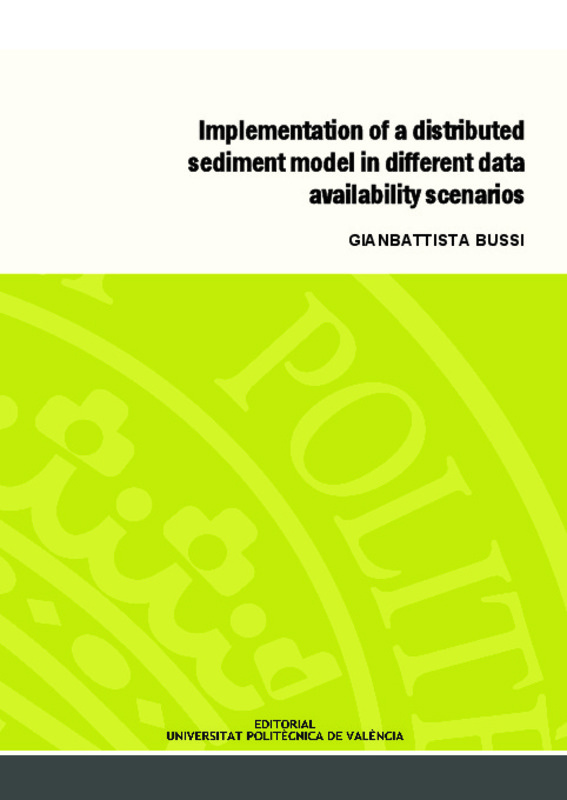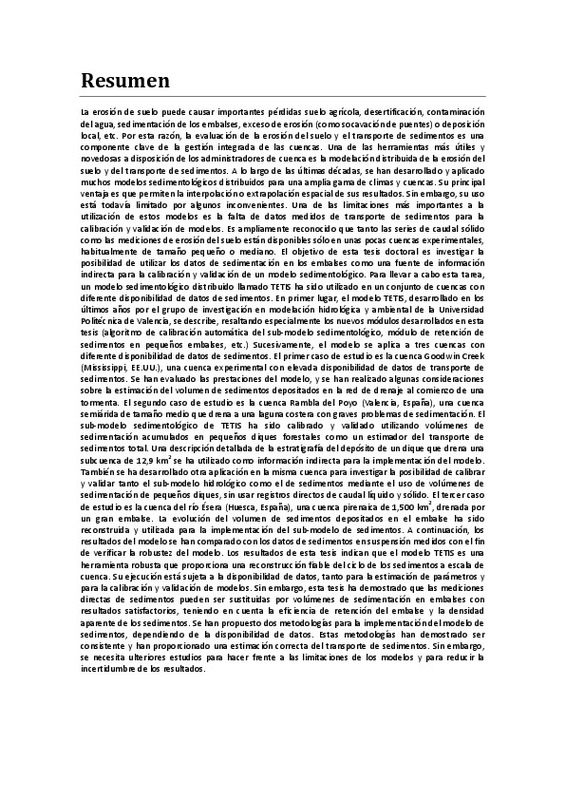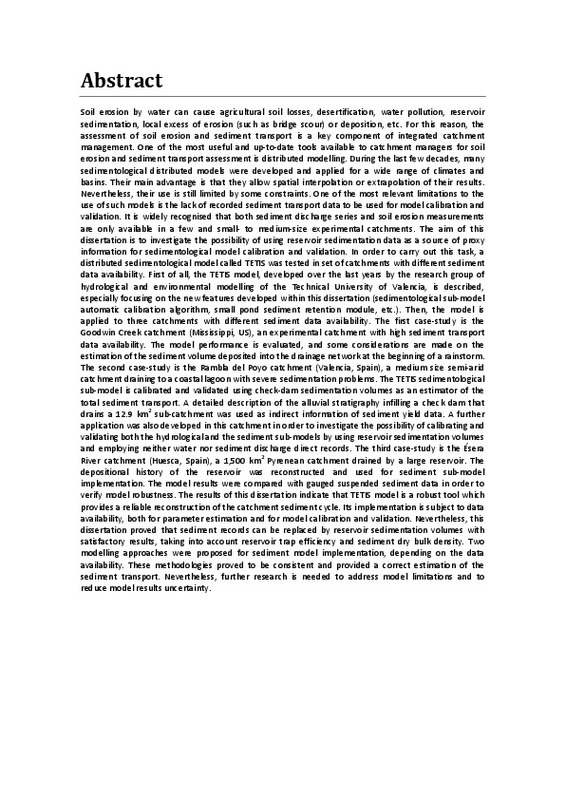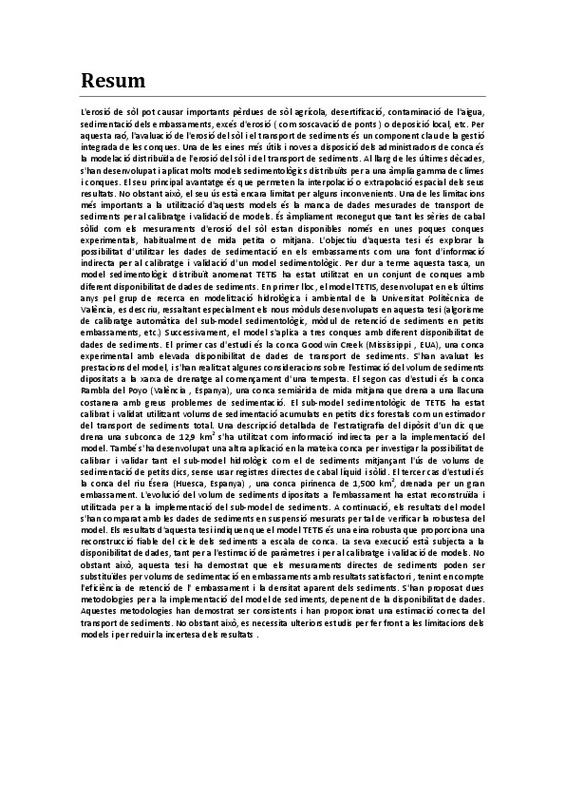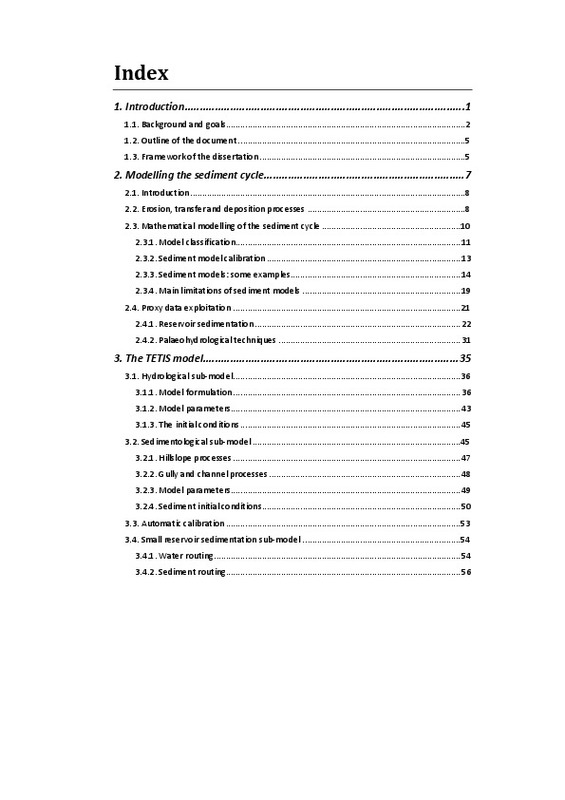- RiuNet repositorio UPV
- :
- Investigación
- :
- Tesis doctorales
- :
- Ver ítem
JavaScript is disabled for your browser. Some features of this site may not work without it.
Buscar en RiuNet
Listar
Mi cuenta
Estadísticas
Ayuda RiuNet
Admin. UPV
Implementation of a distributed sediment model in different data availability scenarios
Mostrar el registro sencillo del ítem
Ficheros en el ítem
| dc.contributor.advisor | Francés García, Félix Ramón
|
es_ES |
| dc.contributor.author | Bussi, Gianbattista
|
es_ES |
| dc.date.accessioned | 2014-03-20T10:53:57Z | |
| dc.date.available | 2014-03-20T10:53:57Z | |
| dc.date.created | 2014-02-28T10:30:43Z | es_ES |
| dc.date.issued | 2014-03-20T10:53:53Z | es_ES |
| dc.identifier.isbn | 978-84-9048-215-5 | |
| dc.identifier.uri | http://hdl.handle.net/10251/36534 | |
| dc.description.abstract | Soil erosion by water can cause agricultural soil losses, desertification, water pollution, reservoir sedimentation, local excess of erosion (such as bridge scour) or deposition, etc. For this reason, the assessment of soil erosion and sediment transport is a key component of integrated catchment management. One of the most useful and up-to-date tools available to catchment managers for soil erosion and sediment transport assessment is distributed modelling. During the last few decades, many sedimentological distributed models were developed and applied for a wide range of climates and basins. Their main advantage is that they allow spatial interpolation or extrapolation of their results. Nevertheless, their use is still limited by some constraints. One of the most relevant limitations to the use of such models is the lack of recorded sediment transport data to be used for model calibration and validation. It is widely recognised that both sediment discharge series and soil erosion measurements are only available in a few and small- to medium-size experimental catchments. The aim of this dissertation is to investigate the possibility of using reservoir sedimentation data as a source of proxy information for sedimentological model calibration and validation. In order to carry out this task, a distributed sedimentological model called TETIS was tested in set of catchments with different sediment data availability. First of all, the TETIS model, developed over the last years by the research group of hydrological and environmental modelling of the Technical University of Valencia, is described, especially focusing on the new features developed within this dissertation (sedimentological sub-model automatic calibration algorithm, small pond sediment retention module, etc.). Then, the model is applied to three catchments with different sediment data availability. The first case-study is the Goodwin Creek catchment (Mississippi, US), an experimental catchment with high sediment transport data availability. The model performance is evaluated, and some considerations are made on the estimation of the sediment volume deposited into the drainage network at the beginning of a rainstorm. The second case-study is the Rambla del Poyo catchment (Valencia, Spain), a medium size semi-arid catchment draining to a coastal lagoon with severe sedimentation problems. The TETIS sedimentological sub-model is calibrated and validated using check-dam sedimentation volumes as an estimator of the total sediment transport. A detailed description of the alluvial stratigraphy infilling a check dam that drains a 12.9 km2 sub-catchment was used as indirect information of sediment yield data. A further application was also developed in this catchment in order to investigate the possibility of calibrating and validating both the hydrological and the sediment sub-models by using reservoir sedimentation volumes and employing neither water nor sediment discharge direct records. The third case-study is the Ésera River catchment (Huesca, Spain), a 1,500 km2 Pyrenean catchment drained by a large reservoir. The depositional history of the reservoir was reconstructed and used for sediment sub-model implementation. The model results were compared with gauged suspended sediment data in order to verify model robustness. The results of this dissertation indicate that TETIS model is a robust tool which provides a reliable reconstruction of the catchment sediment cycle. Its implementation is subject to data availability, both for parameter estimation and for model calibration and validation. Nevertheless, this dissertation proved that sediment records can be replaced by reservoir sedimentation volumes with satisfactory results, taking into account reservoir trap efficiency and sediment dry bulk density. Two modelling approaches were proposed for sediment model implementation, depending on the data availability. These methodologies proved to be consistent and provided a correct estimation of the sediment transport. Nevertheless, further research is needed to address model limitations and to reduce model results uncertainty | en_EN |
| dc.language | Inglés | es_ES |
| dc.publisher | Editorial Universitat Politècnica de València | |
| dc.rights | Reserva de todos los derechos | es_ES |
| dc.source | Riunet | es_ES |
| dc.subject | Sediment modelling | es_ES |
| dc.subject | Distributed modelling | es_ES |
| dc.subject | Soil erosion | es_ES |
| dc.subject | TETIS | es_ES |
| dc.subject | Reservoir sedimentation | es_ES |
| dc.subject | Check dams | es_ES |
| dc.subject | Proxy data. | es_ES |
| dc.subject.classification | INGENIERIA HIDRAULICA | es_ES |
| dc.title | Implementation of a distributed sediment model in different data availability scenarios | |
| dc.type | Tesis doctoral | es_ES |
| dc.identifier.doi | 10.4995/Thesis/10251/36534 | es_ES |
| dc.rights.accessRights | Abierto | es_ES |
| dc.contributor.affiliation | Universitat Politècnica de València. Departamento de Ingeniería Hidráulica y Medio Ambiente - Departament d'Enginyeria Hidràulica i Medi Ambient | es_ES |
| dc.description.bibliographicCitation | Bussi, G. (2014). Implementation of a distributed sediment model in different data availability scenarios [Tesis doctoral]. Editorial Universitat Politècnica de València. https://doi.org/10.4995/Thesis/10251/36534 | es_ES |
| dc.description.accrualMethod | TESIS | es_ES |
| dc.type.version | info:eu-repo/semantics/publishedVersion | es_ES |
| dc.relation.tesis | 6906 | es_ES |
Este ítem aparece en la(s) siguiente(s) colección(ones)
-
Tesis doctorales [5213]
-
Tesis. Editorial UPV [172]






